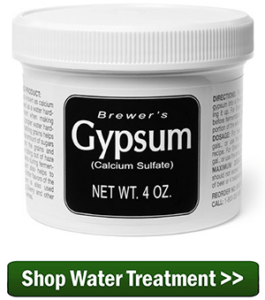 Guest blogger Matt Chrispen shares some tips for adjusting water chemistry when brewing with partial mash recipes. This is part 2 of a 3 part series. To get the whole story start with Part 1.
Guest blogger Matt Chrispen shares some tips for adjusting water chemistry when brewing with partial mash recipes. This is part 2 of a 3 part series. To get the whole story start with Part 1.
Dry Malt Extract (DME) and Liquid Malt Extract (LME) products contain minerals from the mashing process. These minerals provide flavor nuances to the beer and the specific concentrations are proprietary to the maltster, but they directly influence the flavor and mouthfeel of recipe. Extract brewers can further enhance their recipes with additional minerals.
Introduction to Minerals for Brewing
Since the extract brewer is not mashing grain, we can focus solely on flavor components. Ion concentrations of sulfate, chloride, magnesium, and sodium influence perceived flavors and mouthfeel.
- Gypsum or Calcium Sulfate increases calcium and sulfate ions levels. Sulfates generally enhance dryness and increase the sharpness and bitterness of hops.
- Calcium Chloride increases calcium and chloride ion levels. Chlorides tend to round out and enrich mouthfeel and enhance malt characteristics.
- Sea/Kosher Salts or Sodium Chloride (without iodine) increases sodium and chloride ions, and like calcium chloride can enhance sweeter malt forward beers. Not recommended for an extract brewer, except in very traditionally salty styles, such as a gose.
- Magnesium Sulfate increases both magnesium and sulfate ions. Malt extract should contain sufficient magnesium to support healthy fermentation. Only in specific cases is magnesium sulfate useful to an extract brewer.
Water choice is important. Hard water (already rich in minerals) will add minerals into the beer in unknown amounts in addition to the extract’s contribution. By using reverse osmosis (RO) or distilled water, we can exert more control without risking off-flavors, providing a clean starting point for mineral additions.
To keep things simple, we can rely on gypsum and calcium chloride for “seasoning” our homebrew, and the resulting sulfate, chloride, and calcium ion contributions. As mentioned above:
 Sulfates enhance perceived dryness. Increases perceived hop bitterness and sharpness. Pale Ales and IPAs often have elevated levels of sulfates, but large amounts can be off putting.
Sulfates enhance perceived dryness. Increases perceived hop bitterness and sharpness. Pale Ales and IPAs often have elevated levels of sulfates, but large amounts can be off putting.- Chlorides enrich perceived mouth feel and malt flavors. Many darker, malt-driven beers benefit from a small amount of chloride.
- Calcium is beneficial in lowering the boil pH and precipitating proteins (hot and cold break). While there is no direct flavor impact, the resulting wort is clearer and more stable.
These flavors are recipe driven, and should be used appropriately and in moderation. A hoppy pale ale may need a little gypsum where a malty porter might benefit from calcium chloride.
In Part 3, we look specifically at applying these minerals to general beer styles.
———————————————————————-
Series: Part 1 | Part 2 | Part 3
———————————————————————-
Matt Chrispen is a passionate, experienced home brewer, craft beer fanatic, and collector of brewing gear. He also maintains a blog on advanced brewing topics at Accidentalis.com.
